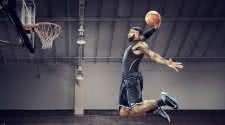Weight Training for Basketball Players - Improve your Shooting

Weight Training has Proven to Help with the Performance of any Sport your Choose!
Basketball is considered a sport for extremely tall, fast individuals. While there is a large skill component involved in becoming an excellent player, jumping ability and endurance are
also important components of the game. Recently, weightlifting has become common practice for many top professional basketball players. Numerous pros can be seen training regularly at
Gold's Gym, Venice, including Mychal Thompson and Mike Smreck. While it was previously thought that weightlifting was detrimental- to sports involving speed and grace, top athletes are
finding that it actually enhances their abilities.
Basketball obviously requires a large aerobic capacity, and by far the best training for this aspect of the sport is to play ball. Other aerobic activities will enhance the body's aerobic
capacity, but they will not be as stress-specific-the concept of specificity of training certainly applies here. One requirement that will not be developed as readily by playing involves
overall strength and power. Both of these are essential for jumping and are important qualities required by forwards and centers, who are constantly engaging in physical contact under
the boards.
While training the upper body is important for overall muscular balance, training the legs should be the primary focus because vertical jumping ability is so critical for the basketball
player. This ability is determined by both leg power and overall bodyweight.
If there are two players of equal strength and power, the lighter athlete will have a higher vertical jump. By this fact alone you can see the importance of developing maximal strength
and power without too much muscular hypertrophy (growth). The training program needs to be geared so the legs remain normal in size yet superior in power. For this reason the weight-training
program for a basketball player must be designed much differently from one for a bodybuilder.
Since most machines are not geared to fit someone who is the height of the average basketball player, a large portion of the training involves free weights. Certain exercises, such as leg
curls and extensions, necessitate the use of machines, so compensatory adjustments must be made.
Height also plays a role in the form used in the exercises. For example, when performing a squat, the length of the femur (bone in the upper thigh) is so long that when placed in a position
parallel to the ground, the lever arm is extremely long, and a large amount of force is placed on the knee joint.
Use extreme caution when beginning a lifting program. Maintain proper form and a full range of motion during all exercises both for safety and for maximal power development of the muscles
used in jumping.
With these factors in mind, let's look at some of the ingredients of an optimal leg workout for the basketball player. Because of the importance of power, the weights used should be maximal
for the given number of repetitions. For power development you need to recruit fast-twitch fibers, and lifting maximal amounts of weights for low repetitions will help you accomplish this.
Keeping the workouts short-few total sets and reps-will limit the adaptations to the fast-twitch fibers and help avoid the increase in size in slow-twitch fibers associated with
higher-repetition training.
The speed with which you perform the movements is also important. Since explosive power is what you're looking for, the concentric contraction should be as rapid as possible while maintaining
proper exercise form. You should think of exploding through the movement, such as exploding upward from the bottom position of a squat. The exercise should not be slow and controlled. The
adaptation you are looking for requires fast, ballistic movements. Most power athletes limit their total workouts for a given bodypart to two to six maximal sets and four to eight repetitions.
A typical leg workout might look like this:
EXERCISE
Lying leg curls1x15 (warmup, 50% max)
1x10 (warmup, 70% max)
1x8 RM*
1x(4-6)RM
1x10
Leg extensions 3x15 (warmup)
Squats
1x15 (warmup 50% max)
1x10 (warmup 70% max)
1x8RM
1x5RM
1x(4-6)RM
1x8RM
1x10 RM
* RM denotes repetition maximum, which is the maximal repetitions that can be performed at a designated weight. Repetition values inside parentheses give a range for repetitions and determine when an increase in weight can take place. When you have attained the higher number of reps, more weight should be added the next workout so that you can only perform the lower number of repetitions.
While this workout is brief by most bodybuilding standards, the basketball player is looking for specific results. Exercises can be substituted for those shown; however, sets and reps should remain the same. Similar training should be done on other bodyparts to increase power and strength without an increase in overall muscle mass. Since only a limited amount of time can and should be designated for weight training, each bodypart should be trained no more than once, or at most twice a week. Workouts in the weight room should only be done two to four days a week depending on how the body-parts are split up and which ones will be worked.
While this program won't turn you into the next Magic Johnson or Michael Jordon, the increased power should increase your jumping ability and your strength to maintain your position against an opponent. The overall power gained from a weight-training program will also increase your overall physical condition and, when combined with the other components of the sport, will make you a better overall player.